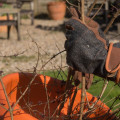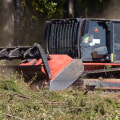Forestry mulching is a land-clearing technique that involves grinding trees, brush, and other vegetation into mulch, leaving behind a nutrient-rich layer that can improve soil health. This method is popular for clearing land while preserving topsoil, which is crucial for the growth of future plantings. After the mulching process, the land is ready for planting, but many landowners wonder what types of plants are best suited for these newly cleared areas. Deciding what to plant after forestry mulching depends on your goals, whether you're looking to restore native vegetation, create a pasture, or establish a garden. Proper planning can ensure that the land flourishes with new plant life and continues to thrive over time.
Assessing Soil Conditions After Forestry Mulching
One of the key benefits of forestry mulching is the layer of organic material left behind, which can greatly improve soil quality. The decomposing mulch provides essential nutrients to the soil, creating a favorable environment for new plantings. However, the thickness of the mulch layer can affect what you should plant next. If the mulch layer is thick, it may take longer to decompose, and you may need to mix it into the soil to speed up the process.
It's important to assess the soil's condition after mulching. In some cases, the land may require additional soil amendments, such as compost or fertilizers, to optimize growth. Conducting a soil test can help you determine its pH level, nutrient content, and whether it needs improvement before planting. Once the soil is ready, you can begin choosing the types of plants that will thrive in this new environment.
Native Plants for Land Restoration
If your goal is to restore the land with native vegetation, choosing plants that are naturally adapted to the local climate and soil conditions is key. Native plants not only require less maintenance but also support local wildlife and contribute to a balanced ecosystem. After forestry mulching, consider planting native grasses, wildflowers, and shrubs that will thrive in the cleared area. These plants often have deep root systems that help prevent erosion and improve soil stability.
Species like switchgrass, little bluestem, and black-eyed Susans are excellent choices for land restoration, as they are hardy, drought-resistant, and provide habitats for pollinators. Trees such as oaks, maples, and pines can also be reintroduced to create a diverse landscape that mimics natural forest conditions. Native plants are generally more resilient to pests and diseases, reducing the need for chemical interventions and helping the land maintain its natural health.
Creating a Pasture or Agricultural Land
For those looking to convert mulched land into pasture or agricultural fields, choosing the right grass or crops is essential. Grasses like Bermuda grass, fescue, and clover are commonly planted for pastureland after forestry mulching. These grasses are known for their durability and ability to establish quickly, providing forage for livestock. Clover, in particular, offers the added benefit of fixing nitrogen in the soil, which enhances fertility for future crops.
If you're planning to grow food crops, it's important to select plants that are well-suited to the local climate and soil conditions. Corn, soybeans, and root vegetables like carrots and potatoes are commonly planted in areas that have been cleared and mulched. These crops benefit from the improved soil quality that comes from decomposing mulch, as well as the additional nutrients provided by cover crops like clover.
Establishing a Garden or Landscape
Forestry mulching can also create the perfect foundation for a garden or landscaped area. The organic mulch left behind provides excellent insulation for plants, retains moisture, and suppresses weed growth. If you're aiming to establish a garden, consider planting vegetables, herbs, and ornamental plants that thrive in nutrient-rich soils.
Plants like tomatoes, peppers, and leafy greens will benefit from the enriched soil, especially if you add compost or organic fertilizers to boost growth. Perennials such as lavender, hostas, and daylilies can be incorporated into the landscape, creating an attractive and low-maintenance garden. When planting shrubs or trees, ensure the mulch is properly integrated into the soil, allowing roots to access water and nutrients effectively.
Wildlife-Friendly Planting
Incorporating plants that support local wildlife can be a rewarding approach after forestry mulching. Consider adding plants that attract birds, pollinators, and other beneficial animals. Flowering plants like coneflowers, milkweed, and bee balm are great for attracting bees and butterflies. Shrubs and berry-producing plants such as elderberry and serviceberry provide food and shelter for birds and small mammals.
Creating a wildlife-friendly environment requires careful planning to ensure that the plants you choose complement each other and provide year-round resources for animals. Additionally, maintaining the health of your newly planted area by addressing pest control concerns is important. Companies like Triangle Critter Control can offer solutions for managing wildlife in your newly planted area, ensuring that your plants thrive without being damaged by unwanted critters.
Conclusion
After forestry mulching, the possibilities for planting are vast, ranging from native vegetation restoration to agricultural development or landscaping. The key to successful planting lies in assessing the condition of the soil, choosing plants that match your goals, and creating a balanced ecosystem that supports both plant life and local wildlife. Whether you’re reintroducing native plants, establishing a pasture, or cultivating a garden, proper planning will ensure that the land continues to thrive after the mulching process. By making informed choices and potentially seeking professional guidance for wildlife management, you can turn a freshly mulched landscape into a flourishing, sustainable environment.



